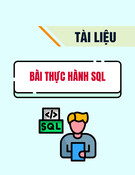
Lecture 32

Chapter 4 "Inheritance"
Inheritance is a powerful feature that allows the reuse of
code.
However, be sure that functions applied to objects created
at run time through the new operator are bound at run
time. This feature is known as dynamic binding, and the
use of virtual functions is required to ensure that run-time
decisions are made.
Reread this chapter as often as necessary to ensure that
you understand the distinctions among
non-virtual functions
virtual functions

Chapter 6 “Algorithm
Analysis"
In this chapter we introduced algorithm analysis and
showed that algorithmic decisions generally influence the
running time of a program much more than programming
tricks do
We also showed the huge difference between the running
times for quadratic and linear programs and illustrated that
cubic algorithms are, for the most part, unsatisfactory
We examined an algorithm that could be viewed as the
basis for our first data structure
The binary search efficiently supports static operations
thereby providing a logarithmic worst-case search

Data Visualization with
MATLAB
Chapter 2 “MATLAB Environment”
Chapter 3 “Built-in MATLAB Functions”
Chapter 5 “Plotting”
Chapter 6 “User-Defined Functions”
Chapter 13 “Numerical Techniques”

Chapter 2 "MATLAB
Environment"
In this chapter, we introduced the basic MATLAB
structure
The MATLAB environment includes multiple windows,
four of which are open in the default view:
Command window
Command history window
Workspace window
Current folder window
In addition, the
Document window




![[Mới nhất] Lecture note Data visualization - Chapter 28](https://cdn.tailieu.vn/images/document/thumbnail/2020/20200723/nanhankhuoctai10/135x160/2961595506403.jpg)
![[Mới nhất] Lecture note Data visualization - Chương 27](https://cdn.tailieu.vn/images/document/thumbnail/2020/20200723/nanhankhuoctai10/135x160/8161595506425.jpg)




















